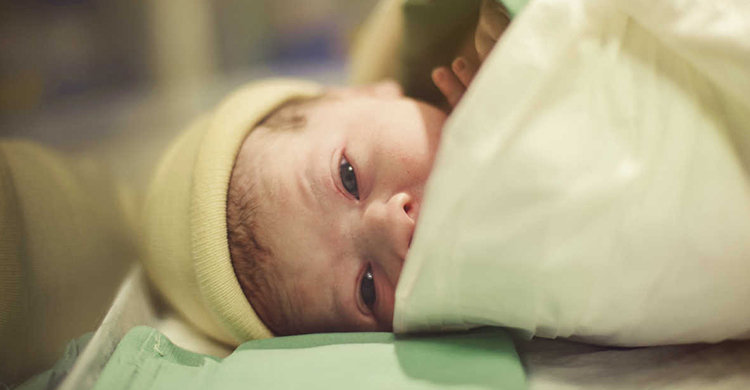
Diaphragmatic hernia occurs when one or more abdominal organs move upwards into the chest through a defect (opening) in the diaphragm. It is important to note that the diaphragm is a dome-shaped muscular barrier between the chest and the abdominal cavity. It separates the heart and lungs from a person’s abdominal organs (stomach, intestines, spleen, and liver).
Diaphragmatic hernia condition is divided into two types, congenital or present at birth (CDH), or acquired later in life (ADH). However, regardless of the type, this condition is a medical emergency and requires immediate surgical intervention for treatment.
Causes of Diaphragmatic Hernia
Congenital diaphragmatic hernia (CDH) is caused by abnormal development of the diaphragm during fetal formation. Defects in the fetal diaphragm allow one or more abdominal organs to move into the chest and occupy the space where the lungs should be. As a result, the lungs cannot develop properly. In most cases, this condition only affects one lung.
Meanwhile, acquired diaphragmatic hernia (ADH) is usually the result of injury. Traffic accidents and falls account for the majority of injuries. Additionally, surgeries on the abdomen or chest can also cause unintended damage to the diaphragm.
Risk Factors for Diaphragmatic Hernia
Most CDH conditions are idiopathic, meaning they are not truly known. It is believed that a combination of several factors may trigger the development of congenital diaphragmatic hernia. Chromosomal and genetic abnormalities, environmental exposures, and nutritional issues may all play a role in the formation of this hernia. Additionally, congenital diaphragmatic hernia is also believed to occur due to problems with other organs. For example, abnormal development of the heart, gastrointestinal, or genitourinary systems.
For acquired diaphragmatic hernia (ADH), here are some risk factors that may trigger it:
- Blunt trauma due to traffic accidents.
- Surgical procedures in the chest or abdomen.
- Falls impacting the diaphragmatic area.
- Stab wounds.
- Gunshot wounds.
Symptoms of Diaphragmatic Hernia
The severity of symptoms of diaphragmatic hernia can vary depending on the size, cause, and organs involved. Here are some common symptoms that may occur due to this condition:
1. Difficulty Breathing
Symptoms of difficulty breathing in congenital diaphragmatic hernia (CDH) are usually severe. This is because these symptoms are caused by abnormal lung development. Meanwhile, in acquired diaphragmatic hernia (ADH), difficulty breathing occurs due to lungs not functioning properly.
2. Tachypnea (Rapid Breathing)
The lungs of individuals with diaphragmatic hernia may try to compensate for low oxygen levels in the body by working faster. As a result, tachypnea or rapid breathing may occur.
3. Changes in Skin Color to Blue
When the body of someone with diaphragmatic hernia doesn’t receive enough oxygen from the lungs, it can make the skin appear blue (cyanosis).
4. Tachycardia (Rapid Heartbeat)
The heart may pump faster than usual to try to supply the body of individuals with diaphragmatic hernia with oxygenated blood.
Diagnosis of Diaphragmatic Hernia
Doctors can generally diagnose congenital diaphragmatic hernia (CDH) before birth through ultrasound examinations (USG). Furthermore, an increased amount of amniotic fluid in the womb can also be an early indication. After birth, babies with CDH may experience the following abnormalities during physical examination:
- Abnormal chest movements.
- Difficulty breathing.
- Bluish discoloration of the skin (cyanosis).
- Absence of breath sounds on one side of the chest.
- Bowel sounds in the chest.
In addition, there are several further examinations to diagnose both CDH and ADH, which are:
- X-Ray. Ultrasound scanning (using sound waves to produce images of the chest and abdominal cavities and their contents)
- CT Scan. Allows direct visualization of abdominal organs.
- Arterial Blood Gas Test. Done by taking blood directly from an artery and testing for oxygen, carbon dioxide, and acidity levels, or pH level.
- MRI. This examination aims to evaluate more focused organs, especially in fetuses.
Treatment of Diaphragmatic Hernia
Both congenital diaphragmatic hernia (CDH) and acquired diaphragmatic hernia (ADH) usually require immediate surgery. Surgery is needed to remove abdominal organs from the chest and relocate them back into the abdomen. Later on, doctors will also repair the patient’s diaphragm.
However, in congenital diaphragmatic hernia, surgical intervention is needed immediately after birth. This is because abdominal organs entering the chest cavity can cause dangerous respiratory system disturbances for the baby. After the surgical procedure, the baby still needs assistance with breathing until the baby’s respiratory system returns to normal and the lungs develop fully.
Diaphragmatic Hernia Complications
Both congenital diaphragmatic hernia (CDH) and acquired diaphragmatic hernia (ADH) carry the risk of several potential complications, such as:
- Pulmonary infections.
- Chronic or long-term lung disturbances.
- Inherent issues and growth disruptions in infants with congenital diaphragmatic hernia (CDH).
Preventing Diaphragmatic Hernia
There’s no specific prevention known to avoid congenital diaphragmatic hernia (CDH). Therefore, couples with a history of diaphragmatic hernia are advised to seek genetic counseling before planning pregnancy.
Meanwhile, preventive measures to avoid acquired diaphragmatic hernia (ADH) include:
- Driving safely and always wearing a seatbelt.
- Avoiding activities that make you vulnerable to significant blunt trauma to the chest or abdomen, such as extreme sports.
- Limiting alcohol intake and avoiding the use of medications that may increase the risk of traffic accidents.
- Being cautious around sharp objects, such as knives and scissors.
When to See a Doctor?
Immediately visit the Emergency Department if you have a newborn baby experiencing difficulty breathing accompanied by an increased heart rate. Emergency surgery is required promptly if this condition is caused by congenital diaphragmatic hernia (CDH).
If you experience difficulty breathing after an accident or surgery, it’s advisable to promptly see a doctor. This is because the discomfort you’re feeling might be a symptom of acquired diaphragmatic hernia (ADH).

